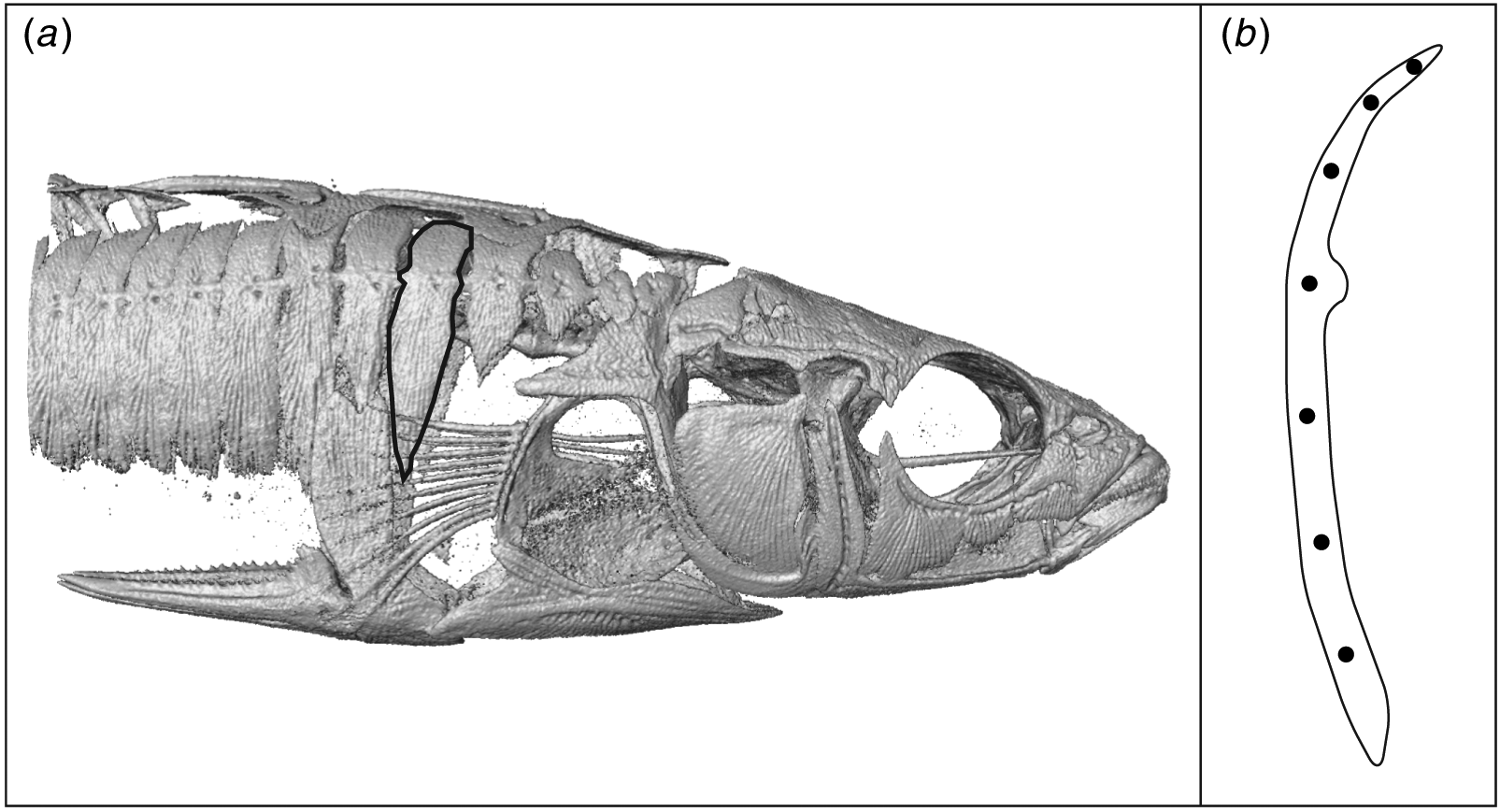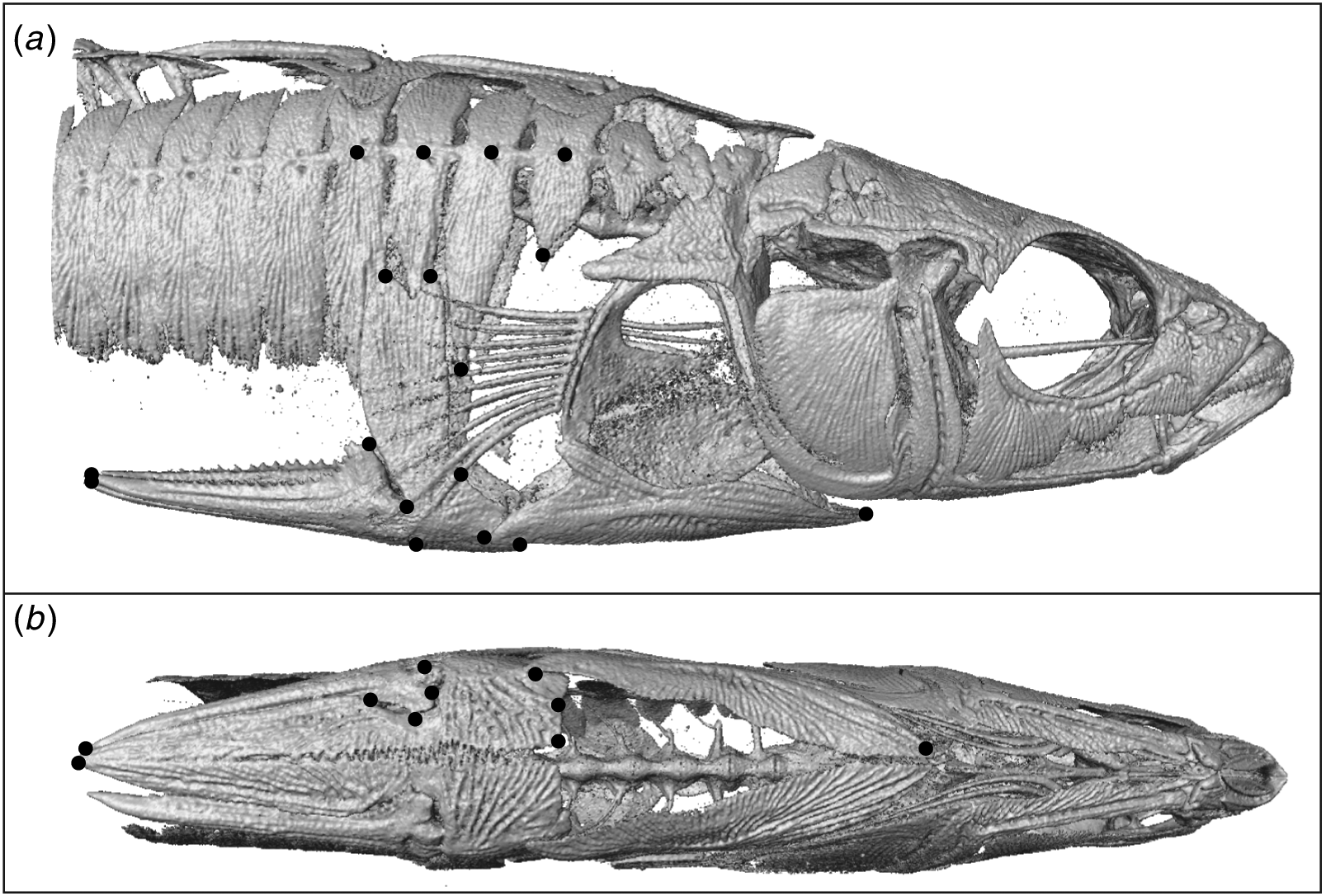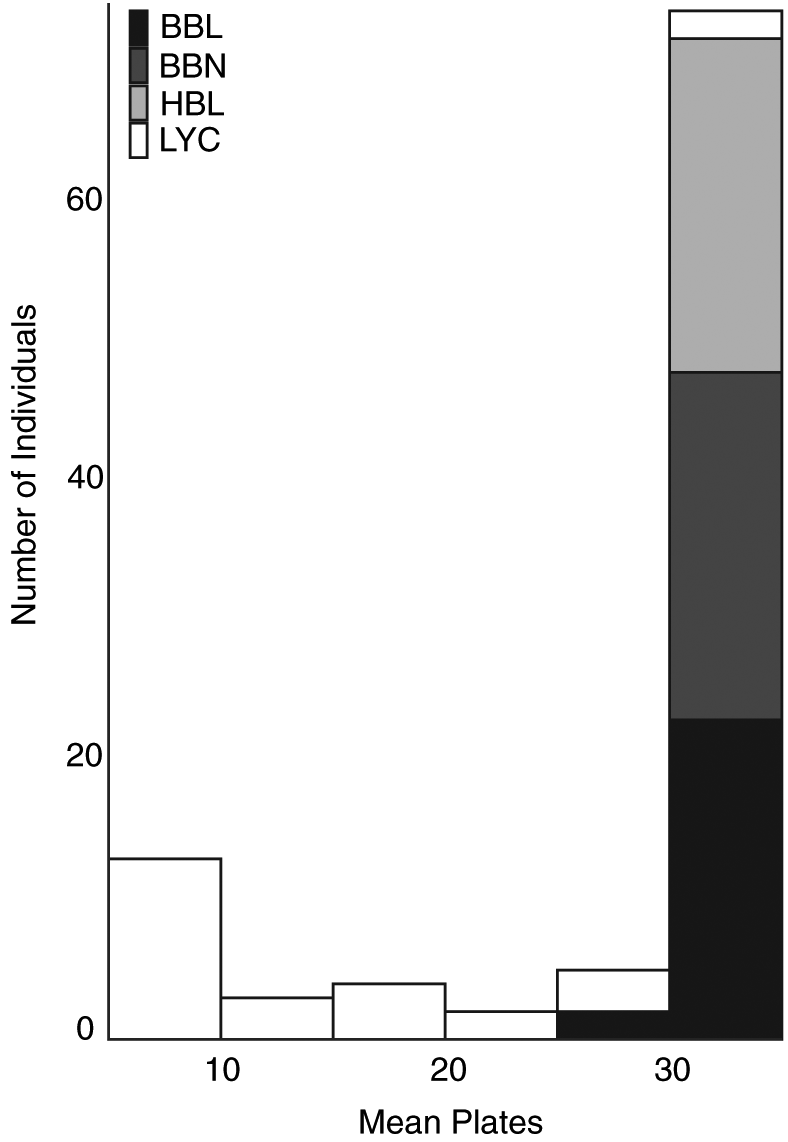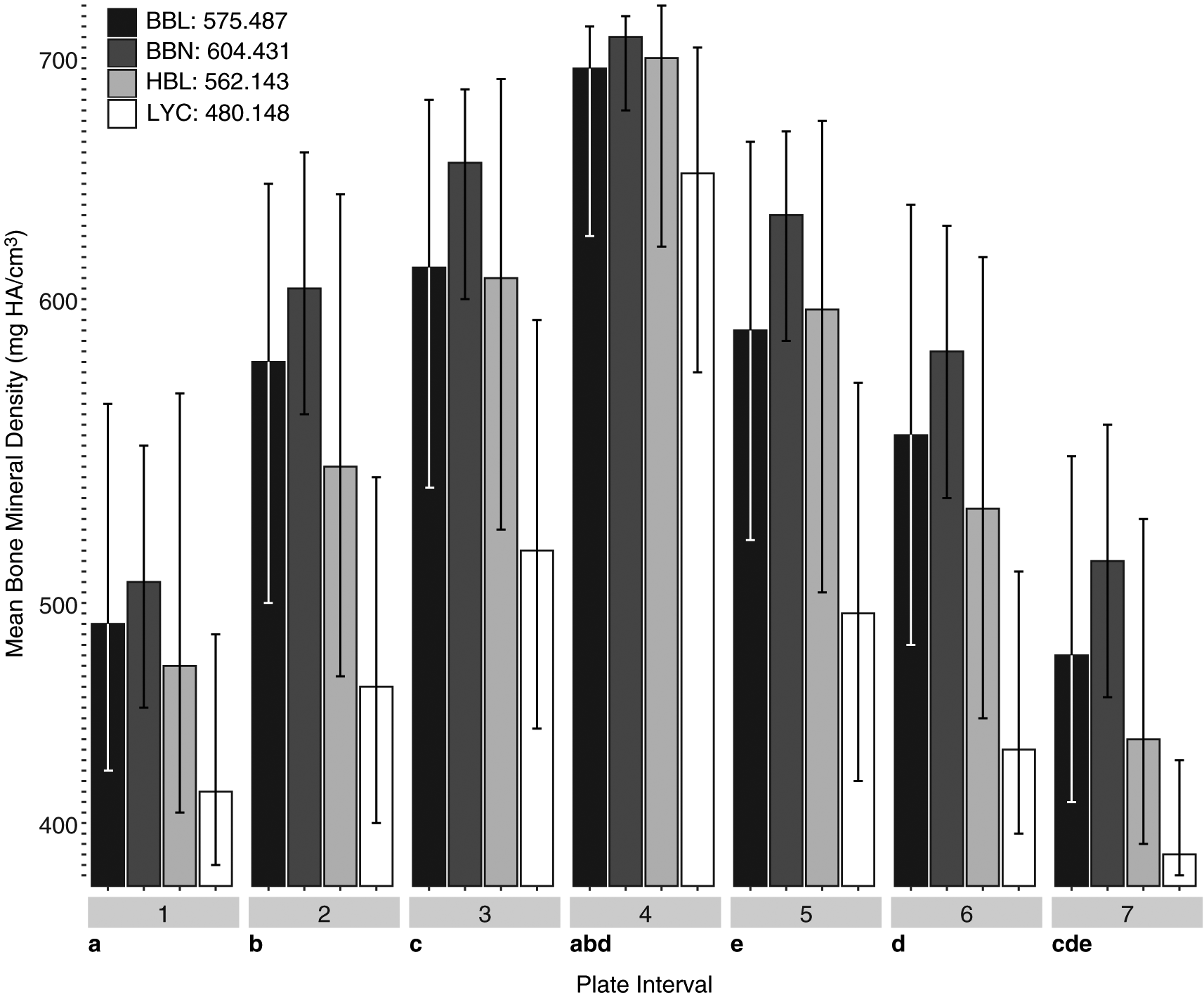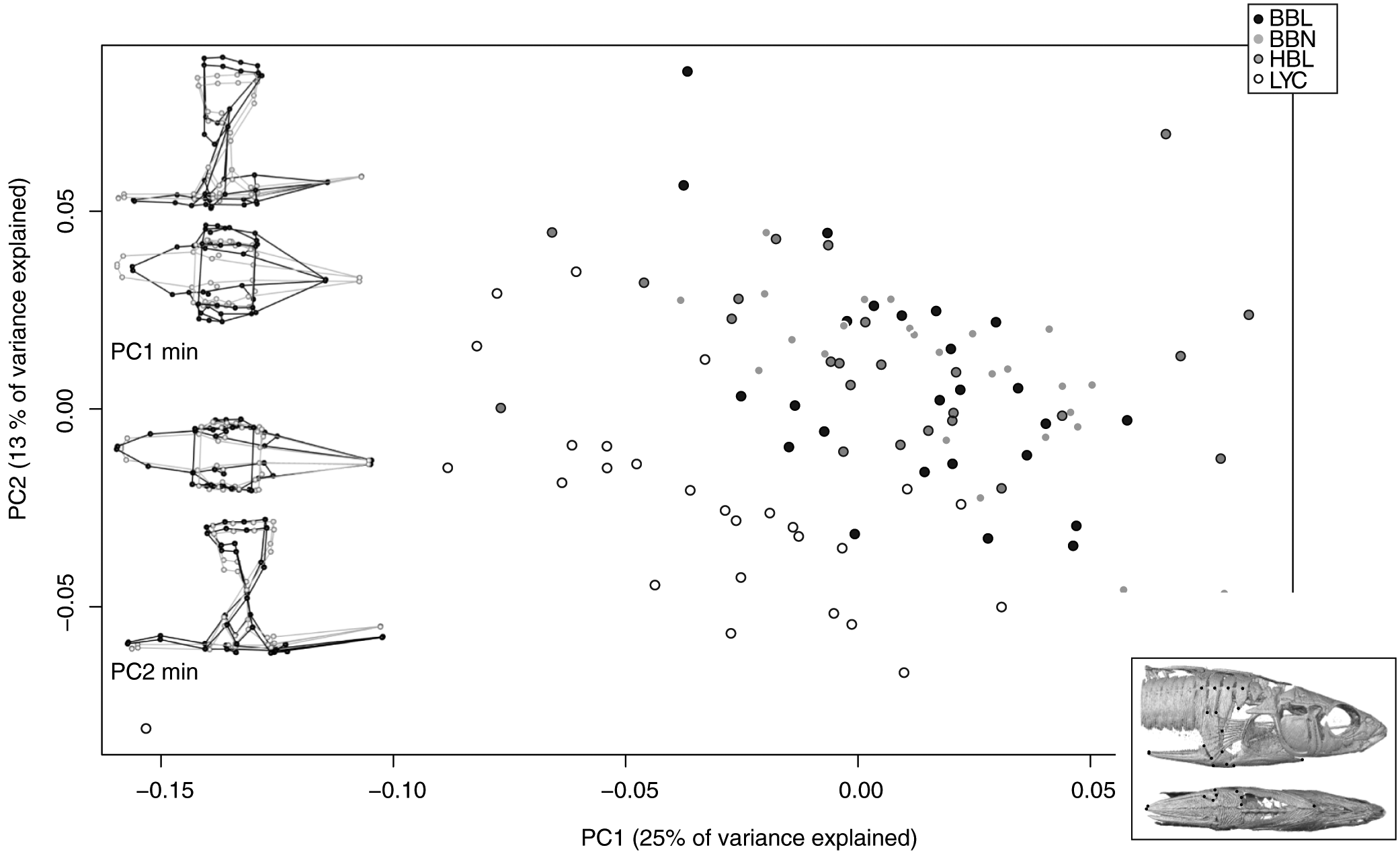Introduction
Although the incorporation of genetic theory and genomic approaches have resulted in substantial gains toward understanding the processes that produce phenotypic variation in nature, it is clear that considerable work remains to be done to understand the nature and complexity of the links between genotype, phenotype, and environmental context that ultimately produce the phenotypes upon which selection can act (
Travisano and Shaw 2013). Within this framework, quantitative studies of phenotypic variation and the detailed characterization of phenotypic complexity remain key to uncovering the developmental and environmental contexts that organisms experience (
Mallarino et al. 2011;
Jamniczky et al. 2015a,
2015b;
Higham et al. 2016).
The threespine stickleback (
Gasterosteus aculeatus Linnaeus, 1758) is an important model for the study of rapid adaptive change and evolution in response to habitat variation. A distinctive feature of this fish is the presence of elaborate bony structural elements, including spines and lateral plates, which act as parts of a functional armour complex thought to be primarily for resisting predation (
Reimchen 1983; but see
Kynard (1979) and
Huntingford (1981) for discussion of the relationship between plate number and aggression in males). Threespine stickleback are known to exhibit parallel changes in plate phenotype, as since the last major glaciation they have repeatedly moved from a marine environment to colonize freshwater lakes and streams (
Bell and Foster (1994)). This phenotypic variation has largely been characterized by a reduction in plate number. Adult marine stickleback normally exhibit between 30 and 36 bony lateral plates, whereas freshwater forms show a range of variation, with those populations that are well established in freshwater habitats exhibiting between zero and nine bony lateral plates (
Hagen and Gilbertson 1972;
Bell and Foster 1994). Plates tend to be lost from the back and the middle of the fish, whereas anterior plates are largely retained to support the spines (
Reimchen 1983).
Plate loss has been extensively studied, and several different hypotheses regarding the putative driver(s) behind repeated loss of plates during invasion of fresh water have been proposed, including changes in calcium availability and the cost of mineralization (
Giles 1983;
Marchinko and Schluter 2007;
Smith et al. 2014), salinity (
Hansson et al. 2016), gradient (
Baumgartner and Bell 1984), maneuverability (
Taylor and McPhail 1986;
Bergstrom 2002), buoyancy (
Myhre and Klepaker 2009), and predation pressure (
Hagen and Gilbertson 1972;
Reimchen 2000;
Kitano et al. 2008). The relative importance of these factors in producing a selective environment that favours plate reduction is still largely unknown, but it has been shown that complete morphs (sensu
Hagen and Gilbertson 1972) exhibit reduced fitness in freshwater environments, and that there may, in fact, be multiple ways to achieve the selective advantage of low-platedness in the face of competing environmental challenges (
Barrett et al. 2008;
Leinonen et al. 2012). Further, it has been shown that divergent selection acting with gene flow can maintain plate morph polymorphism despite directional selection acting on genes known to influence plate phenotype (
Raeymaekers et al. 2014).
Other phenotypic characteristics of plates such as plate composition and size, as well as the relationship between plate phenotype and other aspects of stickleback morphology, remain less well studied and are likely to harbor evolutionarily important variation relevant at the level of both species and population. Stickleback plates are composed of acellular dermal bone (
Sire et al. 2009) and lend themselves well to highly detailed imaging studies. Detailed descriptions of plate microstructure produced using scanning electron microscopy (
Lees et al. 2012) indicate the presence of species-specific variation. Previous work using micro-computed tomography has focused on plate structure within a single anadromous population (
Song et al. 2010), and on comparisons among stickleback occupying different habitats (
Wiig et al. 2016). Substantial variation exists in multiple parameters that is correlated with, but not entirely explained by, salinity, and although both of these studies examined mineralization, they used only single-point measurements to characterize this aspect of plate phenotype. Plate size has also been shown to vary among different populations (
Miller and Hubbs 1969;
Colosimo et al. 2004), and plate number has also been linked to a range of other phenotypic characteristics including body shape, fin shape, and gill raker number (
Gross 1977;
Wootton 1984).
It has long been assumed that marine stickleback form a single, panmictic population across large geographical areas (
Withler and McPhail 1985;
Taylor and McPhail 1999;
Hohenlohe et al. 2010). Yet, evidence of adaptive divergence and population sub-structure within the marine environment has recently emerged (
DeFaveri and Merilä 2013;
DeFaveri et al. 2013). Such structure is partially reflected in the presence of previously underappreciated marine population-level phenotypic variation in complex traits including cranial and postcranial features (
DeFaveri and Merilä 2013;
Jamniczky et al. 2015a,
2015b; M.R.J. Morris, personal communication, 2017). The assumption that marine sticklebacks form a single homogenous population extends to plate phenotypes, where marine fishes have been found to be consistently completely plated (
Bell and Foster 1994), albeit with varying standing genetic variation for
eda, whereas other phenotypic characteristics of plates have not been extensively considered. The nature of the genetic and environmental mechanisms that underlie the maintenance of phenotypic variation in sticklebacks in the marine environment remains poorly understood, and we propose that this may be, in part, due to the inability of relatively superficial trait descriptions (such as plate counts) to adequately describe features of organisms that selection actually sees.
Based on new evidence of diversity in marine populations, we used both traditional histological tools and novel imaging and analysis techniques to more completely characterize threespine stickleback plate phenotype and armour morphology to test the hypotheses that (1) plates are a complex trait with multiple variable phenotypes and (2) that the influence of water type will be apparent in these plate phenotypes. We predicted that plate phenotype will vary within marine habitats as well as in comparison with a population inhabiting a tidally influenced freshwater stream within the same watershed, and that changes to plate phenotype that are correlated with exposure to fresh water will include a reduction in number, decreases in bone mineral density, and changes in shape reflecting the reduction of the extent of the armour complex due to the reduced availability of minerals essential to bone formation in this habitat.
